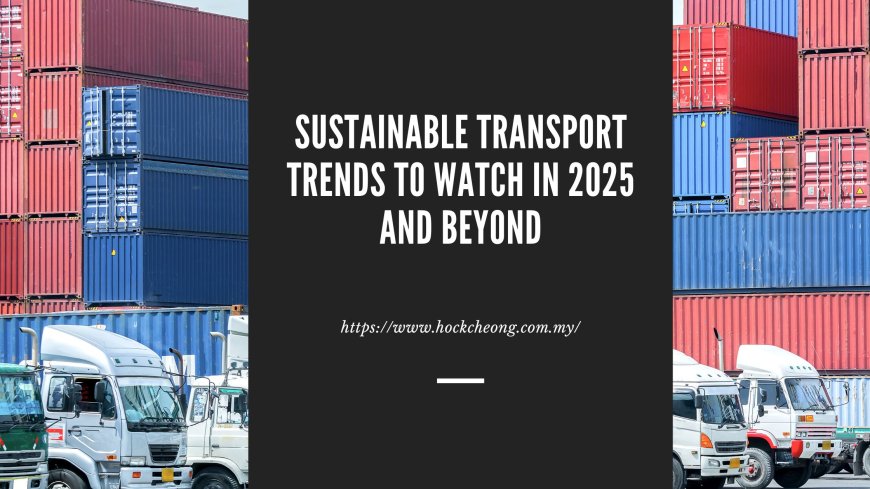Sustainable Transport Trends to Watch in 2025 and Beyond

As the world grapples with the effects of climate change and rapid urbanization, sustainable transport is no longer just a goal its a necessity. Governments, industries, and consumers are shifting towards greener alternatives to reduce emissions, improve urban air quality, and create more efficient mobility systems. With 2025 just around the corner, here are the key sustainable transport trends poised to shape the future of mobility and our planet.
1. Rise of Electric and Zero-Emission Vehicles
Electric vehicles (EVs) are no longer a niche product for early adopters they are becoming the mainstream. Major automakers have committed to phasing out internal combustion engines (ICEs) within the next decade. In 2025, we can expect a surge in EV production, especially with improved battery technology, longer range, and lower costs.
Beyond electric cars, electric buses, trucks, and even planes are gaining traction. Cities across the world from Oslo to Shenzhen are transitioning their public transport fleets to electric. Meanwhile, hydrogen-powered vehicles are also making a quiet but impactful entrance into heavy-duty transport sectors.
2. Expansion of Public Transport Infrastructure
Public transportation remains one of the most efficient and sustainable ways to move people. As urban populations grow, cities are investing heavily in expanding and upgrading their transport networks. Light rail, metro systems, and bus rapid transit (BRT) corridors are becoming more common in both developed and developing countries.
Smart ticketing, real-time tracking, and mobile payment systems are also enhancing the user experience, making public transport more attractive and accessible. In 2025 and beyond, expect to see increased integration between different transport modes like bike-sharing, buses, and metros under unified mobility platforms.
3. Micromobility on the Move
Micromobility options like e-scooters, bicycles, and e-bikes have exploded in popularity in recent years. These lightweight, flexible modes of transport fill a crucial gap in the first and last mile journey. In dense urban environments, micromobility is not only faster but also cleaner and more cost-effective than traditional options.
As we head into 2025, cities are embracing micromobility with better infrastructure including protected bike lanes, dedicated parking zones, and clear regulations to prevent clutter and misuse. The integration of micromobility into public transit systems is also expected to improve, offering seamless door-to-door journeys.
4. Mobility-as-a-Service (MaaS)
Mobility-as-a-Service (MaaS) refers to digital platforms that integrate various transport services such as buses, trains, taxis, car-sharing, and bike rentals into a single on-demand app. These platforms allow users to plan, book, and pay for a multimodal journey in one place.
In 2025 and beyond, MaaS will grow thanks to advances in artificial intelligence, IoT, and 5G connectivity. By making sustainable choices more convenient, MaaS can play a critical role in reducing reliance on private car ownership, which contributes significantly to urban congestion and emissions.
5. Greener Logistics and Urban Freight Solutions
Sustainable transport isnt just about moving people it's also about how we move goods. The demand for e-commerce continues to grow, placing pressure on delivery networks. To reduce the environmental impact, cities and companies are turning to innovative solutions like:
- Electric delivery vans and cargo bikes
- Consolidated delivery hubs
- Drone deliveries for small packages
- AI-powered route optimization to reduce fuel use
In the coming years, urban freight logistics will focus more on minimizing traffic, emissions, and delivery times through smarter, cleaner technologies.
6. Transit-Oriented Development (TOD)
Urban planning is beginning to shift toward transit-oriented development a design approach that focuses on creating walkable communities around efficient public transport systems. TOD reduces the need for long car commutes, promotes active lifestyles, and enhances accessibility to jobs and services.
Expect to see more mixed-use developments, pedestrian zones, and car-free neighborhoods near major transit hubs in the coming years. These developments contribute to both environmental and social sustainability.
7. Data-Driven and Smart Transport Solutions
With sensors, GPS, and big data analytics, transport systems are becoming smarter. Data allows city planners and operators to monitor traffic patterns, forecast demand, and optimize routes in real time.
For example, AI can adjust traffic lights dynamically to reduce congestion, while machine learning can help predict public transport demand spikes. In 2025 and beyond, well see more cities using data-driven tools to build more responsive, efficient, and sustainable transport systems.
8. Policy Shifts and Global Collaboration
Governments worldwide are strengthening regulations and incentives to encourage greener mobility. Low-emission zones, congestion pricing, EV subsidies, and carbon taxes are becoming common tools to drive behavior change.
International initiatives, such as the UNs Sustainable Development Goals (SDGs) and the Paris Agreement, are also influencing national transport policies. These frameworks help countries align their strategies for reducing transport-related emissions and promoting equitable access to mobility.
Conclusion: The Road Ahead
Sustainable transport is no longer optional its a strategic imperative for cities, businesses, and individuals alike. From electrification and micromobility to smart planning and policy reforms, the trends shaping transport in 2025 and beyond point to a cleaner, more efficient future.
By embracing these innovations today, we can build mobility systems that are not only environmentally sustainable but also inclusive, accessible, and economically beneficial for all.
Would you like a version tailored to a specific region (e.g., Southeast Asia or Europe) or sector (e.g., logistics, tourism, or government policy)?








































